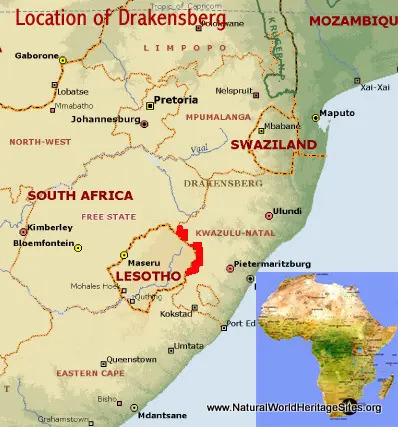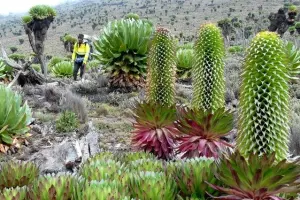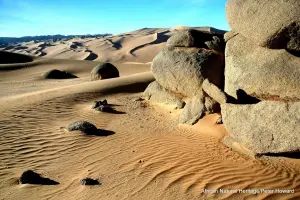EXPLORE THE MALOTI-DRAKENSBERG PARK with this slideshow, check the location map and get all the facts and information below.
For slideshow description see right or scroll down (mobile). Click to view slideshow
Values: The Maloti – Drakensberg Park is located in one of the major mountain ranges of southern Africa with dramatic scenery, high levels of biological endemism, and a concentration of rock art spanning 4,000 years. The highest reaches of its escarpment feature sheer basalt cliffs, with ramparts of golden sandstone rising above high rolling grasslands, rocky gorges and pristine steep-sided valleys. Hundreds of sandstone caves and rock shelters harbour the largest concentration of early rock art in sub-Saharan Africa. These are outstanding in their quality and diversity of subjects, their depiction of animals and human beings and as a record of the beliefs and way of life over 4,000 years of the Khoisan people who used to inhabit the region.
A comprehensive review of the world heritage values of the Maloti-Drakensberg Park is provided below, together with details of the area’s conservation status and the threats it faces.
REVIEW OF WORLD HERITAGE VALUES: The specific attributes which qualify the Maloti-Drakensberg Park for world heritage status under natural criteria can be summarised as follows:
Area of Outstanding Natural Beauty. The park protects some of the most spectacular mountain scenery in Africa, a magnificent escarpment, sculpted by the erosive force of water over millennia, exposing an unrivalled complex of geological features and morphology. From the high plateau on the Lesotho side of the international border soaring basalt cliffs and buttresses mark the sheer, jagged edge of the escarpment which drops precipitously through dramatic cutbacks and, far below, golden sandstone ramparts. There are long grassy spurs, switchbacks and gorges through which waterfalls, pools and rivers flow. This landscape is covered by green grasslands, with displays of spring flowers, which turn to red in autumn and may be snow covered at times during the cold winter.
Exceptional diversity of montane habitats. The diversity of habitats is exceptional, reflecting the great altitudinal range of the Maloti-Drakensberg Park and the complex topographic and geological features. Three primary vegetation zones occur: a montane zone (1,280–1,830 m), a subalpine zone (1,830–2,865 m) and an alpine zone (2,865–3,500 m). The montane zone is dominated by grassland communities, with Protea parkland on most of the spurs and crests. The grassland continues up into the subalpine zone, with species of Helichrysum and Senecio, before grading into climax heath in the alpine zone, dominated by Erica, Chrysocoma and Helichrysum. The summits are generally rocky, with patches of bare, shallow soil and rock sheets near the escarpment. Throughout the area, scrub and/or small trees develop in fire-protected areas and, in the montane zone at lower elevations, patches of tall evergreen forest survive on moist streambanks and in deep kloofs where fire is excluded, with trees such as Podocarpus, Olinia, Kiggelaria and Scolopia.
Outstanding plant species richness and levels of endemism. The Maloti-Drakensberg Park is recognised as a Global Centre of Plant Diversity with an extraordinarily rich flora including a total of 2,153 species of plant. A significant feature is the high level of plant species endemism, with 98 species recorded only from this park and a total of 247 species known only from the southern Africa sub-region. Notable amongst the endemic plants is Protea nubigena and the park supports a substantial part of the global range of the endemic cycad Encephalartos ghellinckii. In addition a large number of the plant species are recognised to be internationally or nationally threatened.
Large number of endemic and globally threatened bird species. The avifauna is characteristic of the globally-important Lesotho Highlands Endemic Bird Area and 31 of its 296 recorded species of birds are endemic to the southern Africa sub-region. Amongst the more conspicuous of these endemic birds are the Drakensberg Rockjumper, Drakensberg siskin and Gurney’s sugarbird. The bird fauna includes a number of globally threatened species, and the park is one of the world’s primary breeding strongholds of the endangered Cape Vulture. Other threatened bird species include five species classified as internationally ‘Vulnerable’ (Southern Bald Ibis, Wattled crane, Blue crane, Yellow-breasted Pipit and Black Harrier) and one ‘near-threatened’ species (bush blackcap).
In addition to the outstanding values outlined above, the Maloti-Drakensberg Park is listed under the world heritage Convention’s cultural criteria in recognition of the exceptional quantity and quality of the rock-art found in the area. For more on the area’s cultural values, go to our sister website, African World Heritage Sites.
CONSERVATION STATUS AND PROSPECTS: The area has a long established tradition of conservation and its overall conservation status and prospects are considered to be good. There are, however, a few threats that require constant vigilance and ongoing management intervention. The most significant of these are the spread of alien invasive plant species and the occurrence of fire at frequent intervals (particularly at high altitudes), both of which are likely to impact native plants and biodiversity. In addition the scenic values of the site are being compromised in some localities by inappropriate developments (such as wind farms) in the buffer zone close to the park boundary.
MANAGEMENT EFFECTIVENESS: Protection and management within the two national parks on either side of the international border is generally very effective, but the management authorities need additional support from governments to counter threats to the parks integrity and ensure effective trans-boundary cooperation. There is a Joint Management Committee and Integrated Management Plan for the trans-boundary site, but more needs to be done to strengthen capacity on the Lesotho side of the border (Sehlabathebe National Park). There is an ongoing process of public consultation over management of the buffer zone (where there are settlements) and this is expected to result in improved integration of the site into local and regional plans and greater support for conservation by local communities.
REVIEW OF CONSERVATION ISSUES AND THREATS: The following issues represent specific threats to the ecology, conservation and values of the Maloti-Drakensberg Park.
Invasive Alien Species. The most significant ongoing threat to the site’s biodiversity comes from invasive alien plant species which are able to out-compete the indigenous species, leading to changes in the composition of vegetation communities and loss of species and habitats. The most aggressive and problematic alien plants in the Maloti-Drakensberg area are pine, wattle, and American bramble, all of which are very well established in the park’s buffer zones, where they provide a constant source of seed material for re-invasion of the parks.
Uncontrolled wild-fires. The high-altitude sub-alpine vegetation is being burnt too frequently by fires originating in Lesotho. This is likely to result in the loss of some vulnerable plants and animals and may ultimately lead to some extinction of species unless it can be better controlled.
Infrastructure developments and intensification of land use in the buffer zones. The buffer zones around the parks’ boundaries are subject to a variety of development activities, some of which have a direct impact on the scenic values and biodiversity of the parks. Of particular concern is the proposed development of wind farms in Lesotho, on the escarpment ridge where they may result in the death (and possible extinction) of some raptors, including the endangered Bearded vulture and endemic Cape Griffon vulture. The main road through the Maloti-Drakensberg Park via Sani Pass is being upgraded and this is expected to bring increased vehicular traffic and associated noise, disturbance etc. Expansion of the Letsing diamond mine and developments associated with the Lesotho Highlands Water Development scheme, close to the park’s western boundary, may also have adverse impacts on the park. Much of the area around the parks is densely populated, heavily overgrazed and degraded (particularly on the South African side) leading to increased levels of ecological fragmentation and biological isolation of the Park.
Illegal grazing of domesticated animals. Communally owned areas of the buffer zone are subject to overgrazing and there are regular incursions of domestic stock into park, where the boundary is unfenced. Lesotho’s Sehlabathebe National Park is particularly vulnerable, as well as the high altitude grassland along the (unfenced) international border on the eastern boundary of South Africa’s Drakensberg Park.
Development of inappropriate tourism infrastructure. There are a number of tourism-related infrastructure development proposals in the park and its immediate vicinity, including a cable car and redevelopment of Cathkin Park village, which could adversely affect the park.
Climate change. The possible effects of global warming and climate change on biodiversity and other park attributes are unknown but it is likely that some of the high-altitude plants and animals will become threatened as higher elevations become warmer and species from lower elevations are able to colonise areas that were previously too cold, supplanting the present high-altitude flora and fauna.
Links:
Google Earth
UNEP-WCMC Site Description
Official UNESCO Site Details
IUCN Conservation Outlook
Our Place Photos
Birdlife IBA
Slideshow description
The slideshow provides a comprehensive overview of the Maloti-Drakensberg Park world heritage site, showing its spectacular mountain landscapes, wildlife habitats, plants and animals, threatened species, conservation management issues, local community livelihoods and some of the visitor facilities and typical hiking experiences.
Factfile
Website category: Mountains
Area: 2,428 km2
Inscribed: 2000
Criteria:
- (vii) aesthetic
- (x) biodiversity (and cultural criteria (i), (iii) )





